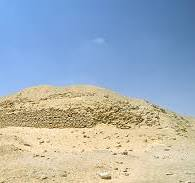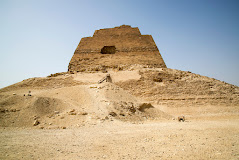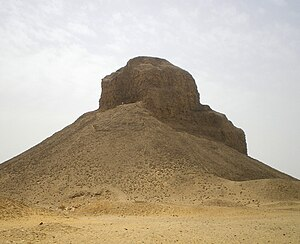Here's another article from the now defunct online magazine PARASCOPE, once part of America Online's Greenhouse Project. This piece I wrote for Donald Trull's department "Enigma," which dealt with various Fortean and ostensibly paranormal phenomena. Modern comments are in red.
Secrets of the Pyramids
by Paul B. Thompson
Nebula Editor
[Obsolete email address deleted]
Few monuments of the ancient world exude as much mystery, wonder and romance as the pyramids of Egypt. For centuries after the tongues of the ancient Egyptians were stilled, travelers spoke in awe of the silent mounds of stone that dot the western shore of the Nile. Prior to the decipherment of hieroglyphics in the early nineteenth century, very little authentic information could be had about the pyramids. Much of what the world knew came from sources like the Greek historian Herodotus (5th century BC), who described the pyramids of Giza as the tombs of the Pharaohs Cheops, Chephren, and Mycerinus. [These were Greek forms of the Egyptian Khufu, Khafre, and Menkaure.]
He was right as far as that went, but other details Herodotus certainly got wrong -- that the pyramids were built using wooden cranes, that Cheops' daughter prostituted herself in order to obtain stone for her own pyramid (one block per customer... ), or that a subterranean canal conducted water from the Nile to the Great Pyramid, creating an underground island on which Cheops was buried, etc. These tales, like those heard today at any tourist trap, were likely made up to impress travelers by sharp local guides eager for baksheesh.
The fact is, today we know a great deal about the pyramids, who built them, and how. Some details remain murky -- understandable after 4,700 years -- but the religious, cultural, and engineering development of the Egyptian pyramid is well understood after two centuries of scientific study.
In the first two dynasties of unified rule, Egypt's royalty were buried under large mud brick structures known as mastabas (Arabic for "bench"). Mastabas were rectangular mounds whose walls sloped slightly inward. As the deceased pharaoh was as divine dead as he had been when living, shrines were built adjoining the mastaba for worship of the dead god-king. This practice would continue after the Egyptians ceased building royal mastabas and began building pyramid tombs; every finished pyramid has an associated funerary temple, which in ancient times was often considered as impressive as the pyramid itself.
By the dawn of the IIIrd Dynasty (circa 2700 BC), Egypt was sufficiently advanced and prosperous to support ever larger building projects. King Zoser, first monarch of the IIIrd Dynasty, decided to show off his wealth and success by constructing for himself the most imposing mastaba yet. He was fortunate to have as his architect Imhotep, one of the first identifiable geniuses of history. Imhotep designed an impressive mastaba for Zoser, but it wasn't grand enough for his royal master. While it was being enlarged, Imhotep had a design breakthrough: he decided to pile other, slightly smaller mastabas atop the original one. Moreover, Zoser's tomb would be wrought in stone, not mud brick. Zoser must have been delighted, for study of his tomb shows it was recast once more with six ascending levels instead of four. The result was the first pyramid in Egypt, known as the Step Pyramid. (The name is purely informational; Zoser's tomb resembles a set of steps.) In its final form the Step Pyramid dwarfed all previous royal tombs, as it was 140 meters long, 118 meters wide, and sixty meters high. An elaborate walled enclosure encompassed the pyramid and mortuary temple into a sacred precinct where Zoser could be revered for all time.
Is the pyramid shape significant, other than as the inspiration of architect Imhotep? Whatever their advances, the Egyptians were limited in what they could build, both by the materials they possessed and the technology they understood. They did not know how to build domes or arches, as the Greeks and Romans used later in their monuments. The pyramid is a simple geometric solid, the only shape other than rectangles the Egyptians could build with the materials and methods they knew.
On the other hand, the pyramid did acquire religious significance. The royal cult was closely linked to worship of the sun god Re. A hieroglyph developed at the dawn of Egyptian history depicts the sun as a phoenix perched atop a pyramid-shaped object called a benben. This benben has been taken to represent the sun's rays spreading to the earth, so a definite symbolic link can be found between the solar cult and the tombs of the pharaohs, the sun god's son on earth.
Considerable speculation has been made about how the Egyptians built their pyramids, from Herodotus's tales of cranes to modern claims of extraterrestrial aid or occult levitation. While interesting, these paranormal theories are unnecessary to explain the pyramids' construction. When we examine the existing pyramids, from Zoser's down to the last royal pyramid tombs of Dynasty XIII (nearly 1,000 years apart), we see different plans, different types of construction, and different materials used. But the pyramids of Dynasties III and IV -- the greatest ones of all -- were built of stone blocks. How did the Egyptians raise all those heavy stones to the heights of the pyramid's peak? What motive force did they use?
As it turns out, they used the simplest methods available: ramps and the muscles of many men. How do we know this? The Egyptians themselves left us the evidence.
Following the reign of the mighty Pharaoh Zoser came an ephemeral king named Sekhem-khet. Like his predecessor, Sekhem-khet resolved to erect a great step pyramid for himself at Saqqara. Unfortunately, Sekhem-khet's reign was brief (six years), and his pyramid wasn't finished. The site was abandoned and gradually covered by the desert. It was not until 1951 that archeologist Mohammed Zakaria Ghoneim found Sekhem-khet's "lost" pyramid. As Ghoneim cleared the site he discovered, to his delight, that long ramps of packed earth and rock were still in place along the sides of the unfinished tomb! Here, as plain as could be, was at least one version of how the Egyptians built their pyramids.
To move the stone blocks into place, the Egyptians used neither wheels nor draft animals, but sledges hauled by men. In some tomb paintings there are scenes of oxen drawing blocks from a quarry, but animals weren't precise enough to use on the pyramid itself. Fewer than a dozen men could manhandle a pyramid building block into place; this can be deduced from a famous scene from the tomb of XIIth Dynasty noble Dhutihotep, in which 172 men drag a colossal statue, many times larger than any pyramid block. The essential ingredient to building a pyramid therefore was steady, dedicated labor and a high degree of social planning. And money -- lots of money, in the form of food and shelter for the pyramid workers. [The pyramid workers were not oppressed slaves, but hired laborers who worked on monuments during the flood season, when their fields were inundated. A few were professional builders--pyramids were their life.]
As the Egyptians had their successes, so did they have their failures. Sekhem-khet's successor, Kha-ba, is believed to have built the so-called "Layer" pyramid at Zawiet el Aryan. Here the Egyptians tried a different form of construction, layering vertical piles of stone into a step pyramid shape. It didn't work, and the Layer pyramid today is a low mound of rubble, whereas Zoser's step pyramid still stands at Saqqara.
One claim often made by theorists who believe the Great Pyramid at Giza has powers and attributes beyond the mundane is that the angle of the pyramid's sides is of special mystical significance. Khufu, son of Snefru, built the Great Pyramid with sides angling up at 51 degrees, 52 minutes. Yet there is no standardization of slope angle among the other pyramids. If the angle of the Great Pyramid were of such cosmic significance, the Egyptians surely would have repeated it in subsequent pyramids -- but they didn't. Virtually every shade of angle from as shallow as 43 degrees to as steep as 65 degrees occurs on pyramids other than Khufu's.
We can even see evidence of miscalculation by the ancient architects as they attempted to build beyond their skills. Snefru's first pyramid at Dahshur, known as the "Bent" pyramid, has a compound angle because the builders changed it halfway through the job. The original angle was 54 degrees, 31 minutes had to be lessened to 43 degrees, 21 minutes when the architects realized the weight of the upper part of the building would crush the burial chamber of Snefru inside. Oops!
Another common objection voiced by those who don't believe the Giza pyramids were tombs is that their interiors are so plain and undecorated, with simple stone tubs instead of elaborate sarcophagi. In fact, before the VIth Dynasty (2340 BC) tombs were not heavily carved or decorated. The common vision of sumptuous funerary equipment stems from the treasures found in New Kingdom tombs, like Pharaoh Tutankhamen's. Fourteen hundred years separates Khufu from Tutankhamen, the same distance between Queen Elizabeth II and Emperor Justinian of Byzantium. Customs evolve, art changes, and economies shrink and grow considerably in fourteen centuries.
It's easy to observe a modern economic phenomenon at work in the history of pyramid building: inflation. Through the last of the Giza pyramids (that of Pharaoh Menkaure), the use of solid stone blocks in the substructure persisted. As the IVth Dynasty faded into the Vth, not even the god-kings of the Nile could afford to build so hugely in costly stone. Even long-lived, powerful pharaohs like Dedkare Isesi (Vth), Teti (VIth), and Merenre (VIth) had to settle for tombs made of stone shells filled with rock, rubble and sand. These hard-shell pyramids might have looked impressive when new, but once the fine stone casing broke, the pyramids collapsed like a broken hourglass. The burial chambers, cut into bedrock below the pyramids, survived. On the walls of VIth Dynasty tombs we first find the famous Pyramid Texts, poetic religious texts intended as guide and comfort to the soul of the dead monarch.
Egypt fell into anarchy after the VIth Dynasty, and few had the power to build even shoddy pyramids. When Theban princes reunified the country under dynasties XI and XII (circa 2134 BC), pyramids tombs were built again.
The XIIth Dynasty pharaohs applied new techniques to pyramid construction. They could not afford solid stone monuments like Khufu's (inflation again), but they saw the ruin that could come to the hard-shell tombs of the VIth Dynasty. Their solution was to build stone or brick "skeletons" inside the pyramid to brace up the exterior casing. The spaces between the ribs were filled with mud brick -- cheap, but more stable than sand and rubble. The internal arrangements of XIIth Dynasty pyramids became more elaborate, and for sinister reasons. The mighty pyramids of previous eras had been plundered during the days of lawlessness. To protect the home of their eternal Ka, XIIth Dynasty pharaohs built tombs of a complexity to delight the fictional Indiana Jones -- false passages, trap doors, hidden chambers -- but no man-traps! The tomb of Amenemhet III at Hawara is the prize of this type of pyramid. Amenemhet's burial chamber was hewn from a single block of quartzite, hollowed into a rectangular box with exquisite precision and sunk into the core of the pyramid. A labyrinth of passages hides it, but even Amenemhet III's grave was eventually robbed.
This fact ultimately led to the end of pyramid building. No tomb, no matter how splendid, was of any use to the pharaoh if it was plundered and his mummy profaned. In the New Kingdom, monarchs turned to remote rock-cut tombs (like Tutankhamen's) to keep their burial secure. It was to no avail. Robbers, incited by the enormous treasure available, found every pharaoh but Tutankhamen, and stripped them of their riches.
Questions remain about the ownership of some pyramids. Money for research is the biggest single impediment to finding any answers.
The pyramids are still wonders, but there is no need to mystify them. Scientific Egyptology has found many answers to their mysteries, and not once has there been a need to involve aliens, Atlanteans, or any supernatural agency. The genius of the ancient Egyptians is manifest. Why should we deny them the treasures of their art and intellect?
(c) Copyright 1996 ParaScope, Inc.









